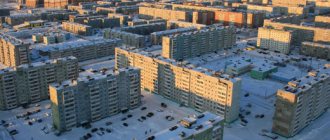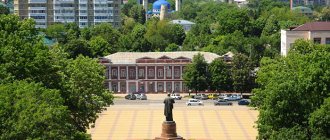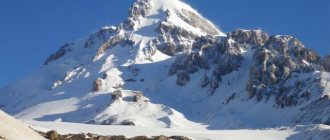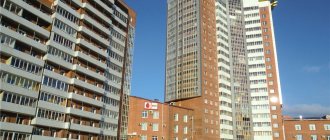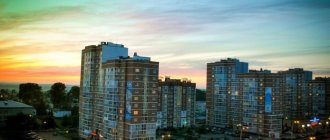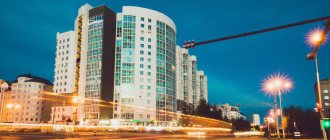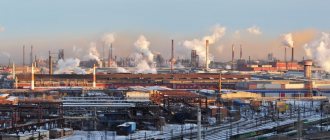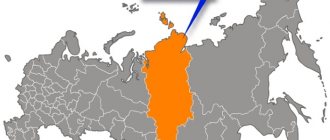Location of the city of Usinsk on the map of Russia in the Komi Republic
On the map of Russia, Usinsk is located in a part of the country that belongs to the European continent. Its location is considered to be in the far north. As for the administrative-territorial position, it is located in the Komi Republic, at its northern border.
The distance to the capital of the autonomous republic – Syktyvkar – is 757 km in the south-west direction. A city district of the same name was formed around Usinsk, the central settlement of which was the city.
Climate and weather by month
Usinsk on the map of Russia is located on the border of the continental and subarctic climate zones. The climate of the settlement belongs to the Dfb category (humid continental climate with warm summers) according to the Köppen classification. It is very harsh, has many features and characteristics characteristic of the subarctic climate zone.
There is snow on the streets approximately 230 days a year - it falls in mid-October and disappears only by June. Winter here is long and harsh, summer is short and not hot. September and October are characterized by constant icy drizzle.
| Month | Average temperature minimum, C0 | Average temperature maximum, C0 | Average air temperature, C0 | Standard amount of precipitation, mm | Average number of days with precipitation |
| January | -24 | -15 | -20 | 33 | 24 |
| February | -24 | -14 | -18 | 26 | 20 |
| March | -17 | -5 | -12 | 25 | 19 |
| April | -10 | +1 | -5 | 28 | 15 |
| May | -2 | +7 | 2 | 36 | 16 |
| June | +5 | +16 | +10 | 47 | 14 |
| July | +9 | +20 | +15 | 59 | 14 |
| August | +7 | +16 | +12 | 67 | 19 |
| September | +3 | +10 | +6 | 62 | 21 |
| October | -5 | +1 | -2 | 51 | 23 |
| November | -14 | -7 | -11 | 44 | 24 |
| December | -20 | -12 | -16 | 39 | 25 |
| Year | -8 | +1 | -3 | 517 | 234 |
The average wind speed is 3.5-4 m/s. The average number of sunny days per year is about 50, with approximately 30 of them occurring in the summer months.
Population
The settlement began its existence as a small working village with a population of 700 people. However, the number of city residents grew exponentially and, approximately 30 years after its founding (in 1992), reached its peak - 53 thousand people.
After the collapse of the Soviet Union, the population began to gradually decline and in 2021 amounted to 38.4 thousand people. This provided the settlement with 405th place in terms of the number of residents among 1,113 cities of the Russian Federation. Usinsk is characterized by natural population growth. This means that more citizens are born here than die.
However, the migration outflow is much greater than the increase, due to which the number of city residents is decreasing.
Usinsk is one of the youngest cities in the Komi Republic in terms of the age of its residents: 70% of the population are of working age, 20% have not yet reached it, and 10% are disabled due to reaching retirement age. The average age of citizens living in the locality is 34 years.
Usinsk is a city where the average age of residents is 34 years
Based on the 2010 census data, Usinsk has the following national composition of the population:
- Russians – 59.6%;
- Komi – 14.8%;
- Ukrainians – 7.6%;
- Tatars – 7.2%;
- Bashkirs – 2.5%;
- Azerbaijanis – 1.5%;
- Belarusians – 1.5%;
- Chuvash – 1%.
Another 4.3% comes from other nationalities (about 40), represented in small numbers. According to the same census, in a populated area there are 1,045 women per 1,000 men.
Usinsk – a city of oil workers
The city owes its birth to oil fields. Despite the difficult natural and climatic conditions, it is an important part of the country’s oil industry. Usinsk today is the oil capital of the Komi Republic.
Our city was founded in 1966. It was a small village, and the people who inhabited it lived at that time in trailers and barracks. The first houses made of timber were built only in the spring of 1970, and on May 1, 1975, the first five-story panel house was put into operation. Usinsk was given city status in 1984.
From the first day of its existence, the city has been multinational. Mosques and churches stand side by side here. I can’t remember any interethnic conflicts. Usinsk was declared a youth Komsomol construction site. People came from all over the vast USSR in search of romance and, of course, money.
The country needed oil, and people extracted it. They built drilling rigs and pulled many kilometers of oil pipelines. Severe frosts and snowstorms could not prevent the development of the rich bowels of the Komi land. The pioneer people were real heroes, strong in spirit and faith in the bright future of their country.
Usinsk is currently a transshipment base for shift workers. Every day a large number of shift workers arrive or depart by airflot and rail. Many people come in search of work. Usinsk is a small city, but it can be difficult to navigate due to the densely packed buildings.
Geographical characteristics
Usinsk is not a very large city with an area of 30,564 km2. The distance from its extreme southern point to the northern is 6.5 km, from the western to the eastern – 11.4 km. The geographic coordinates of the settlement are 660 north latitude and 57.520 east longitude.
It is located on the European continent, almost at the farthest northeastern point.
The settlement is located on the East European Plain, another name for which is the Russian Plain. The Ural Mountains are considered the eastern border of the platform, while Usinsk is located in the very east of the East European Plain - in the Cis-Urals. This territory is characterized by forest-tundra and taiga.
The closest access to the World Ocean for Usinsk is the Barents Sea, or rather its southeastern section, called the Pechora Sea. The distance from the city to the coast is about 300 km due north. In this area the altitude above sea level is about 75 m.
The terrain is flat, the surface is covered with forest-tundra and heavily swamped. Sometimes there are slightly hilly areas. The largest rivers are Usa and Pechora.
In addition, in the Usinsk region there are several smaller rivers:
- Kolva;
- Ski;
- Big Makarikha;
- Sharyu.
The surface waters of this region are represented not only by rivers, but also by swamps, the largest of which is Usinsk. It is one of the largest and most significant systems of raised bogs in the northern taiga on the European continent. The system includes not only swamps, but also approximately 860 lakes.
The soils in this area are dominated by podzolic illuvial-humus and illuvial-iron, bog-podzolic and swamp.
Usinsk is a working city
Usinsk is a small compact town in the Far North.
First of all, it is aimed at working people, since it was originally built to become an outpost for the development of the oil fields of Timan-Pechora. Behind the scenes, Usinsk is called the oil capital of Komi, since oil and gas industry enterprises are concentrated here. People from various regions of Russia come here in search of work. Although to say that wages in Usinsk are high means deceiving thousands of Internet users who can read this information. Salaries are different here, as throughout the country. For example, leading specialists in the oil industry receive from 100,000 rubles, and a cook in a kindergarten receives 18,000 rubles. You can earn more on a shift, but less within the city limits, on average 38,000 rubles.
What are the advantages of working in the North? Long vacation - 52 days and paid travel to and from the vacation spot once every two years. Therefore, many Usinsk residents, as they say, live from vacation to vacation. Earned money - squandered it on vacation. And so on in a circle.
History of Usinsk
The settlement owes its origins to local oil fields. In its development, Usinsk has gone through a difficult path from the first reconnaissance expedition to the modern industrial center of the entire region.
You can find out about the city's attractions here:
The main milestones of this path can be reduced to the following chronological events:
- 1960 - the first drilling rig was installed near the Usa River . It revealed the presence of oil reserves in the depths of the area. Although many years will pass before the appearance of the city of Usinsk, the prerequisites for its emergence appeared precisely at this time.
- 1962, October – the first oil was produced at the Usinsk site.
- 1964 - a village began to be built for oil industry workers.
- August 31, 1966 - a village called Usinsk was officially registered. Geographically, at that time, he was part of the Kolvinsky village council. This day can be considered the founding date of the settlement of Usinsk.
- 1970, March - the foundation of the future city of Usinsk takes place near the village. So far it consists only of wooden houses.
- 1972-1973, winter - the beginning of laying the main oil transportation route - the Usinsk-Ukhta oil pipeline . Already in August 1973, oil began to be pumped along it. This moment marks the beginning of industrial oil production in this area.
- 1973, October 26 - creation of the Usinkneft organization, which managed local oil production.
- 1974, March - the beginning of the construction of the Usinsk-Synya railway, the length of which was 115 km. Usinsk is its final destination.
- 1974 - the village received electricity through the Ukhta-Pechora-Usinsk power line.
- 1974, December 24 - construction of the only secondary school was completed.
- 1975, February 21 - registration of the new Usinsk district, the central settlement of which became the village of Usinsk.
- 1975, May 1 - the first house made of building panels, consisting of 5 floors, was built.
- 1977, January 1 - Usinsk was able to receive and dispatch passenger flights thanks to a new runway.
- 1984, July 20 - the status of the village of Usinsk increased. Now it has become a city.
- 1989, November 18 – the Tomlun cinema was opened.
- 1994, January - Usinsk residents got the opportunity to visit a large swimming pool. It is divided into children's and adults', and there are seats for spectators.
- 1995 - creation of a local museum dedicated to the history and nature of the region.
Main streets of Usinsk
Main highways of the city:
- Vozeyskaya Street - runs exactly along the 66th parallel. Length more than 1 km. It starts from the intersection with Promyshlennaya Street and goes out onto Mira Street, running parallel to Neftyanikov Street;
- Neftyanikov Street – length is more than 4 km. The longest street in the city. Ideally straight, it runs along the southern border of the building from west to east. A highway connecting the city with the village of Parma on the banks of the Usa River departs from it;
- Promyshlennaya Street - length more than 3.3 km. This is one of the longest streets in the city. The street starts at the intersection with Neftchinikov Street and ends at the intersection with Zagorodnaya Street;
- Transportnaya street - length more than 2 km;
- Zavodskaya Street - length more than 3.2 km.
Vozeiskaya and Zavodskaya streets run from west to east, and Promyshlennaya and Transportnaya – from south to north. Promyshlennaya Street in the northern part turns into a road, which later merges with the Pechora - Naryan-Mar highway (Usinsk is located approximately in the middle between these cities). Along the same highway you can get to Ukhta.
The city alley for walking is Molodezhnaya - street-boulevard.
Natural monuments
On the map of Russia, protected natural attractions located in the vicinity of Usinsk are concentrated near the small Sharyu River, the left tributary of the Usa.
These include:
- rock "Ring";
- rock outcrops “Middle Gate of the Sharyu River”;
- Sharyusky natural monument.
The “Ring” rock is located on the right bank of Sharyu , approximately 48 km from the place where the river flows into Usa. Another name for this geological monument is “Window”. The formation is a dolomite rock in the shape of a regular isosceles triangle, the middle of which is hollow.
A void measuring 2.5 x 5 m was formed due to frost weathering processes. The height of the “triangle” is approximately 6 m, the width of the base is 15 m. The attraction is located on a steep slope of the river bank, at a height of 20-30 m above the water surface.
On March 29, 1984, the Council of Ministers of the Komi Autonomous Soviet Socialist Republic classified the “Ring” rock as a geological natural monument.
3.5 km up along the bed of the Sharyu River there is another natural attraction - rocky outcrops “Middle Gate of the Sharyu River” . These include a half-kilometer-long section of the river, similar in appearance to a canyon.
The height of the rocky shores in this area reaches 70 m. The “Middle Gate of the Sharyu River” was recognized as a natural monument under state protection by the Decree of the Government of the Komi Republic in 2002. The Sharyu natural monument can be found at a distance of approximately 50 km from the mouth of the Sharyu.
It is located on both sides of the riverbed. The monument consists of large areas of unique rocky rocks emerging to the surface on the steep slopes of the banks, reaching 60 m in height. The length of the section is approximately 1 km. The exposed rocks are valuable due to the presence of geologically significant fossils in them.
The attraction was taken under state protection at the same time as the “Ring” rock.
Usinsk social
Although at the very beginning of our introductory article it was said that Usinsk is focused on working people, conditions have also been created for the active life of pensioners. In the city, the most efficient public organization in Komi is the Council of Veterans. A lot of events are held here - tea parties, exhibitions, and folk art clubs.
The Veterans Council is especially proud of its choir. This is one of the most famous groups in the city.
Of course, such an active social life of elderly people is possible thanks to the financial support of oil and gas sector enterprises that operate in the municipality and participate in all projects of the Usinsk Veterans Council.
https://vk.com/public106557996
prousinsk.rf
Geography
The city is located in the Urals on the right bank of the Usa River, from which it got its name, 61 km from the Arctic Circle, 757 km northeast of Syktyvkar.
Timezone
Usinsk, like the entire Komi Republic, lives according to Moscow time, that is, the offset relative to GMT is +4:00 (MSK).
Climate
The climate is temperate continental. The average annual temperature is −3 °C. Temperatures in winter range from −20 °C to −40 °C, in summer the maximum temperature is +35 °C. Snow cover lasts 215 days a year.
Natural monuments
The “Ring” rock, a geological monument, is located on the right bank of the Sharyu River, 50 km from its mouth. Standing “on their heads” are layers of dolomite and dolomitized limestone of Silurian age. A hole (“ring”) measuring 2.5x5 meters was formed in one of the layers. The geological monument was created by the Decree of the Council of Ministers of the Komi ASSR on March 29, 1984 as an example of the manifestation of frost weathering.
Rocky outcrops of the “Middle Gate of the Sharyu River”, a geological monument, are located 3.5 km above the “Ring”. A canyon-like section of the river with a length of 0.5 km. The height of the rocks is up to 70 meters. Created by the Decree of the Council of Ministers of the Komi ASSR on March 29, 1984 to preserve the best carbon section of the Chernyshev ridge. Custom security mode.
“Sharyu Natural Monument” is located 50 km from the mouth of the Sharyu River. Continuous rocky outcrops along both banks of the river for 1 km, composed of steeply inclined layers of coral, brachiopods, goniatite limestones, mudstones, oil shale, dolomites. Created by Resolution of the Council of Ministers of the Komi ASSR on March 29, 1984 to preserve one of
the most complete sections of the Upper Silurian, Lochkovian, Frasnian, Famennian stages.
Nature reserves
The Usinsky complex reserve is located in the interfluve of Pechora, Usa, B. Syni, Vyatkina. Created by the Decree of the Council of Ministers of the Komi ASSR on March 29, 1984 (before that, since 1978 - the Usinsk Swamp Natural Monument) to preserve a unique complex of wetlands of international importance.
The Nebesanyur swamp, a swamp reserve, is located on the left bank of the Kolva River. Represents a transitional stage from aapa to hummocky swamps. The vegetation is shrub-forb-sphagnum. The average depth is 2 meters, the maximum is 4 meters. Area - 1700 hectares.
The Usinsky Ichthyological Reserve is located on the section of the Usa River between Cape Pictor and the mouth of the Ponyu River. Includes the bed of the Usa River and forest protection zones on both banks. Area 7.8 thousand hectares. The width of the Usa River within the reserve is 400-600 m, the average depth is 2.5 m, the maximum is 7 meters. The reserve was created by the Decree of the Council of Ministers of the Komi ASSR on March 29, 1984 to protect the spawning grounds and conditions for the reproduction of whitefish.
Natural resources
The city owes its birth to oil and associated gas, the main capital of the local subsoil, the basis of the economic development of the territory. Currently, about 60% of oil and 3% of gas of the total production of these types of raw materials in the Komi Republic are produced in Usinsk.
Industry of Usinsk
The main industry of the city is oil production. Currently, two large oil companies and ROSNEFT are developing oil fields in the Usinsk region. It is engaged in oil transportation (a branch of Transneft OJSC).
Near the city, in the Usinsk region, the world’s northernmost oil refinery with a capacity of 1 million tons per year has been operating since August 2011.
Transport of Usinsk
Railway transport
The final railway station on the Synya - Sinsk line of the Northern Railway (this is the line that was supposed to be extended to Naryan-Mar, to the oil fields).
There is direct communication with the cities of Adler, Nizhny Novgorod, Kirov, Moscow, Novorossiysk, Pechora and Syktyvkar.
Air Transport
The city has its own airport with a runway 2.5 km long. The runway is covered with artificial turf. The airport is capable of receiving heavy cargo aircraft An-12, An-24, An-26; Il-76, Il-114; Tu-134, Tu-154; Yak-40, Yak-42; ATR-42. CRJ-100; Embraer EMB 120 Brasilia; SAAB-2000 and other types of aircraft of 3-4 classes, helicopters of all types. Air based.
In 2012, design for the reconstruction of the airport in Usinsk will begin; the airport should be reconstructed in 2013-2014. In total, funding for these purposes is planned in the amount of 1,329 million rubles. 829 million rubles will be spent from the federal budget on the reconstruction of the airport, 125.4 million from the republican budget, and 374.6 million rubles from extra-budgetary sources.
Automobile transport
There is no road connecting Usinsk with the center of Russia. There are winter roads: Usinsk - Pechora - Vuktyl - Ukhta, as well as Usinsk - Pechora - Israel - Ukhta. The road has been under construction for decades, the distance is about 300 km, there are about 20 km left to the village. Ust-Usa is the nearest populated area, connected by an asphalt road. There is an opinion that the construction of the Usinsk-Pechora highway has been artificially slowed down, since when this highway is put into operation, such large monopolists as Russian Railways and Airways will lose their main income in this direction
River transport
During the navigation period, shipping is carried out (there is a passenger line along the Usa and Pechora rivers). The villages of Ust-Usa, Kolva and the village of Novikbozh, as well as oil drilling sites, are connected to Usinsk by highways.
Urban transport
Bus services operate every day:
- Usinsk — Parma
- Usinsk - Railway Station - Usador
- City ring
- City hospital
- Usinsk - Vodozabor
- Usinsk — Ust-Usa
Architecture and sights of Usinsk
Fountain on the square in front of the pool. It was built at the end of summer 2009.
Monument to “Three Generations” at the intersection of Pripolyarnaya and Neftyanikov streets.
Large stadium, built in the summer of 2009.
Monument to S. Dusouche (pioneer of the industrial development of the North) in front of the Palace of Culture.
Stone of Friendship on the alley on the street. Youth.
Urban development and planning
The city is built up mainly with 5- and 9-story panel and brick houses, except for the Pionerny district, where mainly 2-story barrack-type houses are built.
In 2008, construction began on a new brick multi-storey building with an improved layout with built-in office space and its own garage complex on Mira Street. The construction of this house was completed in 2010. At the moment the house remains uninhabited.
Education and science in Usinsk
In Usinsk there are 6 secondary schools and one elementary school. There are 11 kindergartens and one orphanage. There is a university - a branch of the Ukhta State Technical University. There is also an Open Shift School. In Usinsk you can get secondary vocational education at the Polytechnic College (formerly Lyceum No. 36).
Interesting Facts
Vozeiskaya Street runs exactly at 66° N. Sh.
In 1994, an oil spill occurred in the Usinsk region. It was the largest accident on land, which was included in the Guinness Book of Records.
- Country Russia
- Federal subject – Komi Republic
- Urban district – Usinsk
- Head of Administration of the Municipal Municipality "Usinsk" - Stanislav Yuryevich Khakhalkin
- Founded – 1966
- City - since 1984
- Center height – 67 m
- Population – 42.3 thousand people / 2011
- Agglomeration – 47.4 thousand people / 2011
- Time zone – UTC+4
- Telephone code – +7 (82144)
- Postal codes – 169710, 169711, 169712
- Vehicle code – 11, 111
Nature reserves
Natural reserves of the Usinsk region are represented by:
- Usinsk complex reserve;
- Nebesanyur swamp;
- Ichthyological reserve.
The Usinsky complex reserve is a collection of reservoirs, mainly represented by swamps.
The reserve covers the vicinity of 4 rivers:
- Pechora;
- Usa;
- Big Son;
- Bolshaya Vyatkina.
Nebesanyur is a nature reserve, which includes a whole complex of swamps. It is located to the right of the Kolva River. The flora includes 52 species of plants (shrubs, grasses, sphagnum). The reserve covers an area of 1600 hectares.
The Usinsky Ichthyological Reserve includes a section of the Usa River from Cape Pictor to the confluence of the Ponyu River into the Usa, as well as forest lands on both sides of the Usa. Its area is 7800 hectares. This territory was declared a nature reserve by the Decree of the Council of Ministers of the Komi Autonomous Soviet Socialist Republic dated March 29, 1984 in order to create safe conditions for the spawning of fish of the whitefish family.
Natural resources
The Usinsk urban district is located in the forest-tundra and extreme northern taiga zones. 11.8% of the area is covered with swamps, another 23.2% is covered with vegetation: shrubs and trees. Most forests consist of coniferous trees, spruce being the most common, sometimes mixed with birch. The forest areas have the configuration of large islands.
Vast areas are covered with swamps. The fauna of the region is represented by animal species characteristic of both the tundra and taiga.
The forest-tundra zone is inhabited by:
- reindeer;
- polar wolves;
- white partridges;
- swans;
- geese;
- ducks
The following types are typical for the taiga:
- moose;
- the Bears;
- hares;
- stoats;
- martens;
- foxes;
- proteins;
- wood grouse;
- black grouse;
- hazel grouse.
The main mineral resources of the Usinsk region are oil and gas. 70% of the oil and 60% of the gas of the entire Komi Republic is produced here.
The main oil and gas fields include:
- Verkhnevozeiskoe, located 101 km north of Usinsk;
- Usinskoye, located 20 km northwest of the city;
- Vozeiskoe, located 75 km north of Usinsk;
- Baganskoe, the peculiarity of the weather conditions is frequent snowstorms, the distance to Usinsk is 60 km.
In addition to hydrocarbon raw materials, the subsoil of the Usinsk region contains some other minerals:
- Thanks to the abundance of swamps, the area is rich in peat. However, it is not mined, although a large number of deposits have been discovered.
- Mineral building materials (sand, gravel) are mined to service the oil industry. Reserves of expanded clay, building stone, and mineral pigments have been discovered.
- Ground waters, mineral and fresh.
Industry of Usinsk
70% of the industrial capacity of the Komi Republic is located in the Usinsky region. About 27 thousand people are involved in labor activity. The main share of industrial production falls on the development of oil and gas fields. This industry in Usinsk is represented by the two most significant oil producing enterprises: Lukoil and Rosneft.
Transportation of extracted hydrocarbon raw materials is carried out by the company, which is a branch of Transneft PJSC.
On the map of Russia, Usinsk is located in a region where exploration is revealing more and more new oil deposits, so this industry will determine the future development prospects of the area for a long time. However, the industry of Usinsk is represented not only by oil production.
There is a plant for large-panel house construction here . The food industry is represented by a plant for the production of bakery products and a plant for the processing and production of meat and dairy products. The region's climate does not support extensive agricultural development.
Nevertheless, in the Usinsk region, vegetables are grown in greenhouses and fodder crops in open ground. Cattle breeding is represented mainly by reindeer herding and breeding of Kholmogory cows. This breed was bred in northern Russia and is the most resistant to the harsh conditions of the region.
Current situation
During the years of Soviet power, the city developed rapidly, new microdistricts were built and the territory was improved. Over ten years, the population of the city of Usinsk more than doubled, reaching 47,219 people by 1989.
After the collapse of the Soviet Union, the city continued to develop thanks to the oil industry. The offices of the largest Russian oil producers and Lukoil are located in Usinsk. Global oil service companies (Schlumberger, Halliburton, Nabors Drilling and Baker Hughes) opened their branches in Usinsk.
The number of residents continued to grow - by 1998, 49,600 people lived here. This is the maximum number of people who have ever lived in the specified locality. In subsequent years, the population of Usinsk constantly decreased, mainly due to natural reasons. In 2021, the city had a population of 38,800.
Architecture and sights of Usinsk
The architectural landmarks of the city are two churches. The Temple of the Icon of the Mother of God “Softening Evil Hearts” was built of wood in 2003. The stone Church of the “Resurrection of Christ” in artistic decoration is second only to one church in the Komi Republic - St. Stephen’s Cathedral.
Features of the settlement are the following monuments and attractions:
- a fountain with light and music, the construction of which was dedicated to the 25th anniversary of Usinsk;
- the monument to the defenders of the Fatherland is dedicated to participants in 3 wars: the Great Patriotic War, Afghan and Chechen;
- bust of S.A. Dusouche, a geologist who was among the first to explore the lands of the north;
- stadium;
- monument to the oil worker mosquito.
Usinsk also has:
- city exhibition hall VORTAS, where you can see works of artisans and artists of Usinsk and neighboring settlements;
- Museum of History and Local Lore;
- the Usinsk mosque is the largest in the Komi Republic;
- Oilman statue;
- Monument to the First Builders;
- amusement park;
- Usinsk Palace of Culture.
Usinsk is a vacationing city
In addition to working days, the calendar includes weekends and holidays. How do Usinsk residents relax?
In Usinsk there is a modern Ice Palace "Yugdom", a swimming pool and a Sports School, and there is a Health Path, which is loved by all citizens - both children and adults. It originates near the Church of the Resurrection of Christ and goes deep into the taiga, to the Chernaya River. Dozens of Usinsk residents come to the trail to take a light stroll away from the city’s polluted roads, enjoying the cleanest air; take a photo against the backdrop of small sculptures, of which there are many along the trail; have a family picnic on the roadside; in winter, take a dip in an ice hole or just admire nature. It is beautiful here in any season: in winter, when the trees are buried in snow; in the fall, when lingonberry bushes with beaded berries turn red along the roadsides, and only in the summer do annoying midges and mosquitoes disturb the peace of vacationers.
In recent years, in the wake of promoting a healthy lifestyle in Usinsk, cycling has become especially popular. The close location of the city to the forest line contributes to its development. Enthusiasts have built a bicycle trail in the taiga and, throughout the summer and autumn, until the first frost, regularly hold citywide bicycle rides in which everyone can take part.
For lovers of nightlife, there are several restaurants and entertainment centers in Usinsk.
For young ladies who spend all weekend in beauty salons, there are a huge number of offers in this area.
Urban development and planning
The streets in the city are straight. Residential development is mainly represented by houses made of building panels with 5 and 9 floors. In the Pionerny district there is a small number of 2-story barracks. A new generation house appeared in the city in 2010. It features an improved layout and the presence of garages for residents.
The lower floors are occupied by offices.
Education and science in Usinsk
The following institutions operate for preschoolers and schoolchildren in Usinsk:
- 11 kindergartens;
- 1 orphanage;
- 1 school for primary schoolchildren;
- 6 secondary schools;
- Center for Additional Education for Children;
- an open shift school for high school students who combine study with work or obtaining a profession.
For secondary vocational education, there is a Polytechnic College in Usinsk, and a branch of the Ukhta State Technical University for higher education.
Shock construction
At first, the construction of a new city in the tundra was carried out at a normal pace. By the end of 1974, the first school building was built, and in the spring of the following year the first five-story panel building was put into operation. Unlike many northern cities, Usinsk has neither a private sector nor barracks-type houses. The entire city was built up with five and nine-story buildings.
The construction of the city was declared an All-Union shock Komsomol construction project; young people from all over the country came here to work. Construction of buildings and complex infrastructure was carried out at a rapid pace in harsh circumpolar conditions. What became possible with operational management in the distribution of labor and material resources. The population of Usinsk began to grow rapidly, and by 1979 there were 19,513 people living in the village.
Interesting facts about the city
Although the history of the city goes back a little over 30 years, Usinsk managed to stand out with some interesting features and events:
- Usinsk was formed later than all other cities of the Komi Republic. After it was given city status in 1984, not a single similar settlement was formed.
- The Usinsky district is noted in the Guinness Book of Records due to a sad reason - in 1994, a major oil spill occurred here, the consequences of which are still felt by the Usinsk residents.
- Vozeiskaya Street coincides with line 660 north latitude.
- Of all the cities of the Komi Republic, only Usinsk has no sights immortalizing Lenin.
- The Yenisei oil refining enterprise operates in the Usinsk region. It is located north of all similar enterprises in the world.
- The Usinsk bog is one of the most extensive peat bogs in Europe. In the Komi Republic it ranks second in size. The distance between the extreme northern and southern points of the swamp is more than 40 km, its age is over 9 thousand years.
Despite its small size on the map and short period of existence, Usinsk is in the top 100 industrial centers of Russia.
Article design: E. Chaikina
Usinsk cultural
Despite the fact that Usinsk is a provincial city, there is a Palace of Culture with the most spacious auditorium. It is the center of the cultural life of the Usinsk people. The Center of National Cultures is based in the palace, which unites many amateur artistic groups - the ensembles “Bulgar”, “Chervona Kalina”, “Azeri”, “Rus Pechora”, “Edelweiss”, “Nairi”, “MEOTIDA”. All of these groups take part in the city’s festive events and also hold their annual concerts.
In addition, in the Palace of Culture itself there are many children's dance groups, as well as vocalists. Russian pop stars often come to Usinsk - then the stage of the Palace of Culture is at their complete disposal.
For those whose musical tastes are more refined, there is a School of Arts in Usinsk. Here children learn to play various musical instruments, study painting and other areas of high art.
Another island of spirituality can be called the Usinsk Museum and Exhibition. Not only professional craftsmen exhibit their works here, but also amateurs - talented Usinsk residents - photographers, puppeteers, folk craftsmen.
